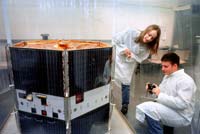U. of Colorado’s ’Little Satellite That Did’ set for re-entry in coming days

Former CU-Boulder students Erica Rodgers and Stan Straight put the finishing touches on SNOE just prior to launch in early 1998. Photo courtesy of the University of Colorado
A $5 million University of Colorado at Boulder satellite dubbed the “Little Satellite That Did” now is expected to re-enter the atmosphere and burn up in early December following a successful six-year mission.
The Student Nitric Oxide Explorer, or SNOE, is carrying instruments that have measured nitric oxide in the upper atmosphere that affects Earth’s ozone layer, the intensity of X-rays from the sun and ultraviolet light from Earth’s aurora. Developed at CU-Boulder’s Laboratory for Atmospheric and Space Physics by students, engineers and faculty, the mission has been controlled from LASP’s CU Research Park facility 24 hours a day by students and faculty since early 1998.
“The SNOE satellite has been determining the influence of the sun on Earth’s upper atmosphere by measuring the amount of nitric oxide in the atmosphere,” said Charles Barth, former LASP director and principal investigator of SNOE. Produced when solar X-rays are absorbed into the atmosphere, nitric oxide destroys naturally produced ozone when injected into the stratosphere 30 to 50 miles above Earth.
“NASA’s latest predictions indicate that SNOE will re-enter the atmosphere on Dec. 5,” he said. “However, we are anticipating more solar storms in the next few days that may cause it to come in earlier. We still are studying the effects of the solar storms on the atmosphere, so any large storms in the next several days will be good news for our scientific studies and bad news for the lifetime of the satellite.”
Orbiting at more than 300 miles above Earth, SNOE has helped CU-Boulder scientists and students map the effect of global X-rays on the atmosphere. SNOE data have shown that nitric oxide levels in the mesosphere correlate with the 27-day cycle of solar X-rays coming from the sun.
In addition, the researchers discovered that when charged particles sent rocketing to Earth by solar storms slam into Earth’s magnetic field and are injected into the polar regions, they produce both Aurora Borealis and Aurora Australis. “The same particles that cause the aurora also produce the nitric oxide in the upper atmosphere,” said Barth.
This helps CU researchers determine how much energy is injected in the polar regions, he said.
Roughly 60 students from disciplines ranging from business, film studies and computer science have participated in the on-campus control of SNOE, said Randy Davis, LASP’s mission operations director. LASP currently controls five satellites.
SNOE’s design and construction phase involved more than 100 students, primarily undergraduates, said Davis. SNOE was one of three spacecraft selected for flight by the Universities Space Research Association in 1994 as part of NASA’s Student Explorer Demonstration Initiative. CU’s spacecraft was the first to launch.
“It is remarkable to me how successful SNOE has been,” said Davis. “The reasons we built SNOE in-house was the opportunity of involving more than 100 students in the project from design and construction to satellite control and the tremendous science SNOE was capable of doing. We have extremely competent and enthusiastic students here.”
From 1981 to 1989, CU students and faculty controlled the Solar Mesosphere Explorer satellite from campus, the first NASA satellite ever entirely operated and controlled by a university. SNOE was the second.
The three-foot-diameter, 220-pound spacecraft was launched on a Pegasus expendable-launch vehicle built by Orbital Sciences Corp. of Dulles, Va. The Pegasus carried the satellite to an altitude of 40,000 feet by jet aircraft and dropped into a five-second free fall. SNOE then ignited horizontally and began ascending, placing it in a circular orbit about 340 miles above Earth within 10 minutes.
CU students tapped into the expertise of engineers from Ball Aerospace Corp. — which built the Solar Mesosphere Explorer satellite — and the National Center for Atmospheric Research, working side by side with them in all phases of the project.
The operations were supported in part by a special excellence award from the Colorado Commission on Higher Education, said Davis.
“During the final months of SNOE’s lifetime, the students formed a SNOE re-entry team to carefully monitor the satellite’s performance,” said Barth. “This has been a truly unique experience for CU-Boulder students to participate in from launch to re-entry.”
The SNOE research team expects almost all of the satellite to burn up during re-entry, with perhaps a few small fragments falling into the ocean.
Additional information on the SNOE project can be found on the Web at http://lasp.colorado.edu/programs_missions/present/off_site/save.html.
Additional Contacts:
Randy Davis, (303) 492-6867
Jim Scott, (303) 492-3114
Media Contact
All latest news from the category: Earth Sciences
Earth Sciences (also referred to as Geosciences), which deals with basic issues surrounding our planet, plays a vital role in the area of energy and raw materials supply.
Earth Sciences comprises subjects such as geology, geography, geological informatics, paleontology, mineralogy, petrography, crystallography, geophysics, geodesy, glaciology, cartography, photogrammetry, meteorology and seismology, early-warning systems, earthquake research and polar research.
Newest articles

Future AR/VR controllers could be the palm of your hand
Carnegie Mellon University’s EgoTouch creates simple interfaces for virtual and augmented reality. The new generation of augmented and virtual reality controllers may not just fit in the palm of your…

‘Game changer’ in lithium extraction
Rice researchers develop novel electrochemical reactor. A team of Rice University researchers led by Lisa Biswal and Haotian Wang has developed an innovative electrochemical reactor to extract lithium from natural…

The blue-green sustainable proteins of seaweed
… may soon be on your plate. The protein in sea lettuce, a type of seaweed, is a promising complement to both meat and other current alternative protein sources. Seaweed…



